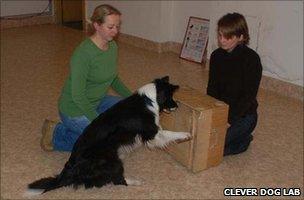Dogs 'mimic movements of owners'
- Published

Dogs "automatically imitate" the body movements of their owners, according to a study.
This automatic imitation is a crucial part of social learning in humans.
But Austrian researchers report that the phenomenon - where the sight of another's body movement causes the observer to move in the same way - is evident in many other animals.
They say that it reveals clues about how this type of learning evolved.
The study, which was led by Dr Friederike Range from the University of Vienna in Austria, also suggests that the way in which people interact with and play with their dogs as they are growing up shapes their ability to imitate.
"It's not a spontaneous thing," said Dr Range. "The dogs needed a lot of training to learn it."
She and her colleagues investigated this imitation with a series of trials using a simple door-opening test.
The team built a box with a sliding door on the front that could be opened with a knob.
The owners demonstrated how to open the door by using either their hand or their mouth.
"When the owners used the hand, the dog had to open the door with its paw to get a reward," Dr Range said.
When the owner opened the door with their mouth, the dog had to use the same technique.
Dr Range explained to BBC News: "A second group of dogs had to learn the alternative method - if the owner used their hand, they had to use their mouth, and when the owner used their mouth, they had to use the paw."
'Mirror neurons'
The dogs that had to imitate the same action as their owner learned their task far more quickly.
This showed that the dogs had a predisposition to imitate their owners' hand/paw and mouth/muzzle movements.
She noted that, because dogs have a very different body shapes to people, they also had to interpret what they saw.
"This type of learning has obvious evolutionary advantages for animals," Dr Range said. "They can learn about certain aspects of life without having to learn by trial and error, which always comes with some risk."
The new evidence supports a theory of learning which suggests that a system of "mirror neurons" and the capacity to imitate are forged as an animal learns and develops, rather than this system being inborn.
- Published27 August 2009